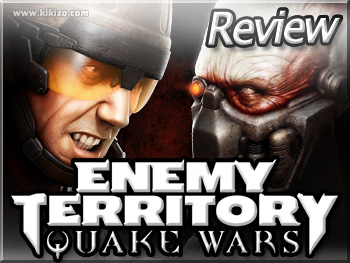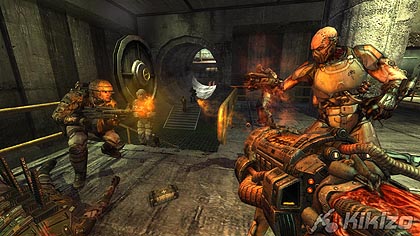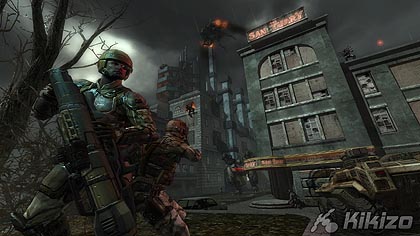Enemy Territory: Quake Wars
Did Splash Damage prove worthy of the Quake license?
| Version PC, Xbox 360, PS3 | Developer Splash Damage | Publisher Activision | Genre Strategy |
||||
Boom, blam and indeed: blamoomo. Fans of blowing crap up rejoice, for we are in the midst of being spoilt by all the destructive delights thrown our way. There's that little Halo 3 thing, there's the astounding Orange Box, there's some other things I've forgotten about - Crysis, I suppose, if you have a PC built like a tank - Unreal Tournament 3 is popping up soon enough, as well as Call of Duty 4.

It's a shame really, as it means a lot of great games are going to be forced onto the wayside - fortunately, Enemy Territory: Quake Wars has enough of a sickeningly devoted following (owing to the success of the previous Wolfenstein version of the game) that you're always going to be looking at servers packed to the rafters.
With people that can snipe you from eighteen miles away.
Yes, ET:QW is an online FPS, and as such it means I seemingly do nothing but lose at it. Operating with the class-based system that served the last ET title so well - bar a few streamlining changes here and there - ET:QW works on the principle that a team should work together. Whilst the good ol' Lone Wolves can go about their business, a team working as one unit will utterly trounce an opposition not working as such, and vice-versa.
Aiming to encourage team play to a greater degree, Quake Wars offers separate missions depending on which character class is picked - engineers (or their Strogg equivalents) are the only ones that can build fortifications and repair as necessary, for example, so will be called to do so as the mission dictates. While they are going about their business, the assault classes may be asked to provide support fire, or maybe liberate a forward spawn point. It's all very well done, I have to say, and works wonders in convincing those that normally run around in circles on their own (me) to actually work with the rest of the team.
The classes are limited to five per team - soldier, medic, field ops, engineer and covert ops and their Strogg equivalent, which basically means the same thing but with different, nasty-sounding names. Each class is capable of more than just what their name would suggest, and each has a specific use for each mission, as previously mentioned. This class depth is enough to keep things fun to play whilst at the same time making it familiar enough to get stuck straight in. And get shot in the face from a dozen miles away. Bitter? Moi?
Aside from the classes, everyone is able to take control of a number of different vehicles - from the more standard tanks, jeeps and helichoppers of the human side to the hover tanks and walking bipedal monstrosities of the Strogg. And, of course, ATVs. All the vehicles are easy enough to control, as well as being easy enough to crash, and it doesn't take someone with a pilot's licence to get the choppers off the ground - Battlefield 2 take note (I know this was fixed in BF2142, but I ignore that game, so there).
The maps can be played in a few different ways - campaign mode sees players taking on three maps in a cycle, performing their side's missions and seeing who wins come the end of the run. Stopwatch sees players trying to complete missions faster than their opposition can. Finally there's objective, which is the same as campaign, but only on one map. It isn't the widest of selections, but there's enough in the way of quick thrills to keep you coming back for more. There's also an offline mode where bots can be twotted, but that's completely counterproductive - this is an online game, through and through.
There's a semblance of backstory behind the game, but it's almost as irrelevant as the narrative behind Doom - Strogg (alien bastards) have landed on Earth. GDF (human goodies) are trying to stop them. It's flimsy at best, but if it tried to be anything more than that it would clearly be an affront to anyone with intelligence.
ET:QW scales back decently, though low-end machines will struggle to be honest. It's quite surprising, as the game doesn't look that spectacular - though it may be down to the large maps and that whole MEGATEXTURE crap that was being spouted. I don't know, technology my strong point is not. Nevertheless, if you meet the minimum specs you'll be fine, as long as your broadband connection isn't provided by numptys. Anyone treading over the minimum spec line is unlikely to have many problems at all, with things looking decent enough - like a sci-fi Battlefield 2 - and loading times more than bearable.
Generally speaking, this sums the whole game up - it's nicely steamlined and does its job well. Everything is made more than bearable, to the point of being pleasant, and it's clear that the chaps and chapettes at Splash Damage know what they're doing. ET:QW is balanced, fun to play and has a great deal of depth beyond its seemingly shallow surface.
| ||||||||||||
|















 Satoru Iwata Video Interview - the late Nintendo president spoke with Kikizo in 2004 as 'Nintendo Revolution' loomed.
Satoru Iwata Video Interview - the late Nintendo president spoke with Kikizo in 2004 as 'Nintendo Revolution' loomed. Kaz Hirai Video Interview - the first of Kikizo's interviews with the man who went on to become global head of Sony.
Kaz Hirai Video Interview - the first of Kikizo's interviews with the man who went on to become global head of Sony. Ed Fries Video Interview - one of Xbox's founders discusses an epic journey from Excel to Xbox.
Ed Fries Video Interview - one of Xbox's founders discusses an epic journey from Excel to Xbox. Yu Suzuki, the Kikizo Interview - we spend time with one of gaming's most revered creators.
Yu Suzuki, the Kikizo Interview - we spend time with one of gaming's most revered creators. Tetris - The Making of an Icon: Alexey Pajitnov and Henk Rogers reveal the fascinating story behind Tetris
Tetris - The Making of an Icon: Alexey Pajitnov and Henk Rogers reveal the fascinating story behind Tetris Rare founders, Chris and Tim Stamper - their only interview? Genuinely 'rare' sit down with founders of the legendary studio.
Rare founders, Chris and Tim Stamper - their only interview? Genuinely 'rare' sit down with founders of the legendary studio. The History of First-Person Shooters - a retrospective, from Maze War to Modern Warfare
The History of First-Person Shooters - a retrospective, from Maze War to Modern Warfare